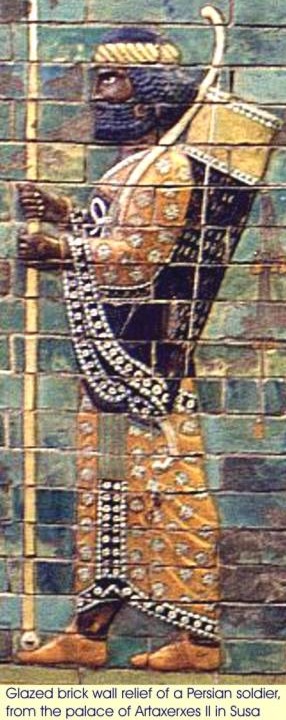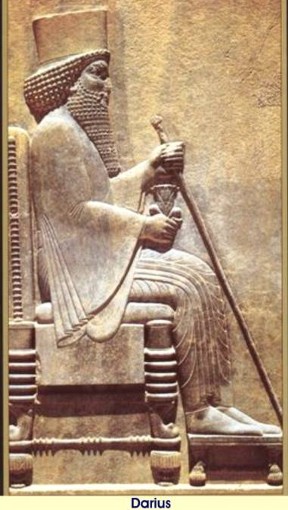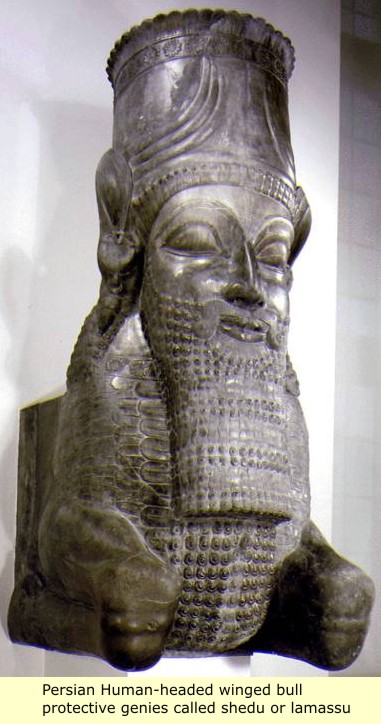Two particular books that give alot of evidence which really is too much to type out here are
Black Sumer: The African Origins of Civilisation (Volume 1) and
Black Sumer: The Physical Evidence (Part One)
Black Sumer: The Physical Evidence (Part Two)
yes that is right, there are so many pictures it fills TWO books!
I'll just give a summary
The works are all heavily cited with works from other professors, which is not hard to find because it was widely accepted as you saw from my previous quote that they were cusheeites or black.
According to Strabo, the 1st Elamite colony at Susa (Elam) was founded by Tithnus, a king of Cush. Strabo in Book 15, Chapter 3728 wrote that in fact it is claimed that Susa was founded by Tithonuss Memnon's father and his citadel bore the name Memnonium.
-Rawlinson used two african languages to decipher the cuneiform writing and believed it was africans that founded mesopotamian civilization
-Professor, William Leo Hansberry, Harvard
African History Notebook
, (1981) Volume 2 notes that:In Persia the old Negroid element seems indeed to have been sufficiently powerful to maintain the overlord of the land. For the Negritic strain is clearly evident in statuary depicting members of the royal family ruling in the second millenium B.C.
Tithnus, a King of Kush. Strabo in Book 15, Chapter 3728 wrote that in fact it is claimedthat Susa was founded by Tithonus Memnon's father, and his citadel bore the nameMemnonium. The Susians are also called Cissians. Aeschylus, calls Memnon's mother Cissia.William Leo Hansberry,
African History Notebook
, (1981) Volume 2 noted that:In Persia the old Negroid element seems indeed to have been sufficiently powerful tomaintain the overlord of the land. For the Negritic strain is clearly evident in statuarydepicting members of the royal family ruling in the second millenium B.C.
Hundreds of years later, when Xerxes invaded Greece, the type was well represented in the Persian army. In the remote mountain regions bordering on Persia and Baluchistan, there isto be found at the present time a Negroid element which bears a remarkable resemblance to the type represented on the ancient mounments. Hence the Negritic or Ethiopian type has proved persistent in this area, and in ancient times it seems to have constitutednumerical ly and socially an important factor in the population" (p.52) ibid
There is sufficient textual evidence supporting a relationship between the founders of Sumer, Elam and Dilmun. Sir Henry Rawlinson , used textual evidence to determine that a link existed between the Mesopotamians to their ancestors in Africa . Rawlinson called these people Kusheeites. William Leo Hansberry gives a great discussion of the evidence of African Kusheeites ruling in Asia and Africa. Some ancient scholars noted that the first rulers of Elam were of Kusheeite( Kerma ) origin including strabo.
Dr. GJK Campbell-Dunn in his works: Sumerian Comparative Grammar and Sumerian Comparative Dictionary. Both books is comparing Sumerian with Niger-Congo languages and shows the link.
"I have looked at Sumerian and can explain all the Sumerian determinatives as Niger-Congo", asserts Dunn. Perhaps a bit naively, he also adds that people "dont seem interested" in his two books on Sumerian. His linguistic analysis and rather widely spread knowledge and interest in ancient archeology and African population movements may allow him to see Sumerian as a derivative of Niger- Congo where other Africanists, more specialized, cant or wont."
Professor Campbell Dunn, PH.D OXFORD
The link between niger congo languages and sumerian was known from a very long time ago
Comparative Lexical Study of Sumerian and Ntu ("Bantu"): Sumerian, the "Sanscrit" of the African Ntu Languages Paperback – January 1, 1935
by Willibald Wanger (Author)
A Willibald Wanger wrote a book in 1935 titled, Comparative Lexical Study of Sumerian and Ntu ( " Bantu " ): Sumerian, the " Sanscrit " of the African Ntu Languages. Dunn notes that Wanger "was trashed by a German reviewer", but believes him to have been on the right path. Also, in the early 1900s a J. Frederik van Oordt stated with some confidence in, The Origin of the Bantu: A Preliminary Study, the following:
"I have in the first list given a considerable number of Sumerian words which seem to be immediately connected with Bantu expressions having the same meaning. In the comparative list of Bantu, Indian and Malacca languages, it will be, however, seen that the Sumerian, as an Ugro-Altaic language is derived from the same original stock as Bantu. But there are certain facts which show that the connection between Sumerian and Bantu must have been more close and more direct than would have been the case if only common influences were at work"
Van Oordt conceived of a proto-Negroid or black African substratum stretching from the Malaccas[malaysia] to Africa, but with India as the starting point (an Indian origin of humanity being a not uncommon presumption in that era). In response to this supposition, a William Crabtree in 1918 offered some constructive criticism in a book called Bantu Speech a Philological Study, while at the same time claiming on the basis of his own findings that Bantu may reasonably be claimed to belong to the Ugro-Altaic group. Dunn
Elamites

Persian in susa

Darius i






Flat nosed persians? Did they have plastic surgery 5000 years ago?


Black Sumer: The African Origins of Civilisation (Volume 1) and
Black Sumer: The Physical Evidence (Part One)
Black Sumer: The Physical Evidence (Part Two)
yes that is right, there are so many pictures it fills TWO books!
I'll just give a summary
Quote:
| The Sumerian Problem HAS BEEN SOLVED! And the solution is African! According to mainstream historians the Sumerians of ancient southern Iraq founded the world's first civilization. They are supposed to have spoken a language which is not genetically related to any known language. This is known as the Sumerian Problem. This book represents the greatest discovery in ancient history for the last hundred years. It demonstrates that Sumerian was genetically related to the Niger-Congo languages of West Africa. Their descendants are the African Diaspora of North and South America and the Caribbean. Many claimed to have solved the Sumerian problem in the past. Hermstein's differs from previous attempts by first showing the reader how to identify genetically related languages through recurrent sound correspondences in basic vocabulary. He then gives examples from acknowledged genetic relationships such as Germanic to show the reader what the evidence should look like. The author also shows what false correspondences look like and how to tell the difference. He also makes use of a number of tests that would determine whether languages are related using probability. This is CLEARLY UNLIKE ANY PREVIOUS ATTEMPT at solving the Sumerian problem. The author reconstructs the epic voyage that took the ancestors of the Sumerians from a homeland in West Africa to Djibouti before making a journey by sea, around Oman and to the head of the Persian Gulf. The other major discovery in the book is that the Sumerians had a much more advanced system of astronomy than has been supposed. The constellations had geographic associations in the Classical period through myth. Hermstein shows how the geographic coordinates of the associated places closely correspond to the celestial coordinates of certain points within the constellations. It is impossible to develop such a system without knowing the earth is round. The text supplying the point of origin for the system of geo-celestial coordinate correspondence is from the Sumerian period. Two amazing discoveries in one book. Both humanity and civilization have an African origin! The ancients knew a lot more than we realized! |
Quote:
| This book amazingly shows how the pioneer Assyriologists said Mesopotamia had 'Cusheeite' origins! Did you know that there are still Black populations in southern Asia? This book brings proof in pictures! They are the descendants of the ancient civilisation builders of Asia! A wonderful follow-up to Hermstein's first volume showing the ancestors of the Sumerians to be of African origin. This volume concentrates on the skeletal reports produced by physical anthropologists which showed that the Sumerians, Akkadians and Babylonians were a predominantly Black people. It utilises techniques used by the FBI to show the racial affinity of skeletal remains. This is CSI level of proof! This is the must have book for those interested in Black history. Egypt was African. Now Mesopotamian civilisation is shown to have had a Black origin! For those wishing to avoid a Black origin of civilisation they are fast running out of refuges! |
Quote:
| This book reveals that the ancient Babylonians claimed they were ethnically related to the ancient Canaanites, Egyptians and Cusheeites. The Hebrews claimed the same about the Babylonians. A whole chapter deals with the ancient Sumerian sculpture and how their seemingly non-Negroid profiles can be seen in indigenous people from southwest Asia today who have African complexions. Another entire chapter deals with ancient Mesopotamian paintings of Black Gods, kings and dignitaries in colour. Unique pictures never before seen by the Black community. This book finally lays to rest the myth that Mesopotamian art supports a Caucasian origin of the Sumerians! It proves once and for all that Mesopotamia had Black origins! |
According to Strabo, the 1st Elamite colony at Susa (Elam) was founded by Tithnus, a king of Cush. Strabo in Book 15, Chapter 3728 wrote that in fact it is claimed that Susa was founded by Tithonuss Memnon's father and his citadel bore the name Memnonium.
-Rawlinson used two african languages to decipher the cuneiform writing and believed it was africans that founded mesopotamian civilization
-Professor, William Leo Hansberry, Harvard
African History Notebook
, (1981) Volume 2 notes that:In Persia the old Negroid element seems indeed to have been sufficiently powerful to maintain the overlord of the land. For the Negritic strain is clearly evident in statuary depicting members of the royal family ruling in the second millenium B.C.
Tithnus, a King of Kush. Strabo in Book 15, Chapter 3728 wrote that in fact it is claimedthat Susa was founded by Tithonus Memnon's father, and his citadel bore the nameMemnonium. The Susians are also called Cissians. Aeschylus, calls Memnon's mother Cissia.William Leo Hansberry,
African History Notebook
, (1981) Volume 2 noted that:In Persia the old Negroid element seems indeed to have been sufficiently powerful tomaintain the overlord of the land. For the Negritic strain is clearly evident in statuarydepicting members of the royal family ruling in the second millenium B.C.
Hundreds of years later, when Xerxes invaded Greece, the type was well represented in the Persian army. In the remote mountain regions bordering on Persia and Baluchistan, there isto be found at the present time a Negroid element which bears a remarkable resemblance to the type represented on the ancient mounments. Hence the Negritic or Ethiopian type has proved persistent in this area, and in ancient times it seems to have constitutednumerical ly and socially an important factor in the population" (p.52) ibid
There is sufficient textual evidence supporting a relationship between the founders of Sumer, Elam and Dilmun. Sir Henry Rawlinson , used textual evidence to determine that a link existed between the Mesopotamians to their ancestors in Africa . Rawlinson called these people Kusheeites. William Leo Hansberry gives a great discussion of the evidence of African Kusheeites ruling in Asia and Africa. Some ancient scholars noted that the first rulers of Elam were of Kusheeite( Kerma ) origin including strabo.
Dr. GJK Campbell-Dunn in his works: Sumerian Comparative Grammar and Sumerian Comparative Dictionary. Both books is comparing Sumerian with Niger-Congo languages and shows the link.
"I have looked at Sumerian and can explain all the Sumerian determinatives as Niger-Congo", asserts Dunn. Perhaps a bit naively, he also adds that people "dont seem interested" in his two books on Sumerian. His linguistic analysis and rather widely spread knowledge and interest in ancient archeology and African population movements may allow him to see Sumerian as a derivative of Niger- Congo where other Africanists, more specialized, cant or wont."
Professor Campbell Dunn, PH.D OXFORD
The link between niger congo languages and sumerian was known from a very long time ago
Comparative Lexical Study of Sumerian and Ntu ("Bantu"): Sumerian, the "Sanscrit" of the African Ntu Languages Paperback – January 1, 1935
by Willibald Wanger (Author)
A Willibald Wanger wrote a book in 1935 titled, Comparative Lexical Study of Sumerian and Ntu ( " Bantu " ): Sumerian, the " Sanscrit " of the African Ntu Languages. Dunn notes that Wanger "was trashed by a German reviewer", but believes him to have been on the right path. Also, in the early 1900s a J. Frederik van Oordt stated with some confidence in, The Origin of the Bantu: A Preliminary Study, the following:
"I have in the first list given a considerable number of Sumerian words which seem to be immediately connected with Bantu expressions having the same meaning. In the comparative list of Bantu, Indian and Malacca languages, it will be, however, seen that the Sumerian, as an Ugro-Altaic language is derived from the same original stock as Bantu. But there are certain facts which show that the connection between Sumerian and Bantu must have been more close and more direct than would have been the case if only common influences were at work"
Van Oordt conceived of a proto-Negroid or black African substratum stretching from the Malaccas[malaysia] to Africa, but with India as the starting point (an Indian origin of humanity being a not uncommon presumption in that era). In response to this supposition, a William Crabtree in 1918 offered some constructive criticism in a book called Bantu Speech a Philological Study, while at the same time claiming on the basis of his own findings that Bantu may reasonably be claimed to belong to the Ugro-Altaic group. Dunn
Elamites

Persian in susa

Darius i






Flat nosed persians? Did they have plastic surgery 5000 years ago?





No comments :
Post a Comment
Note: only a member of this blog may post a comment.